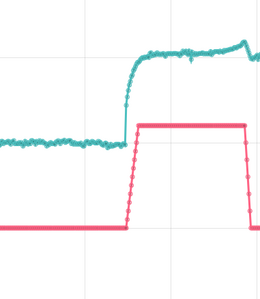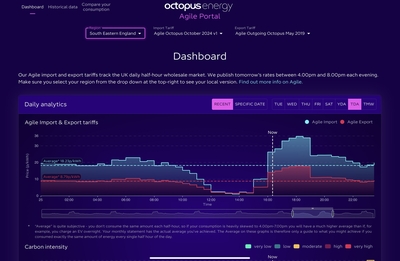Who's your electricity provider and what's your tariff?
Posted by: @old_scientistIs it best to cycle daily on a 80-20-80% regime
That's what most people do if the system offers such a configuration.
Posted by: @old_scientistand how does the charge / discharge rate affect the battery given it can charge at 1.7kW, 3.3kW or 5kW?
There's an obvious risk of damage due to over-charging if your inverter/charger is permitted to reach the 100% level whilst still delivering maximum current.
It's best if the charger successively reduces the current as it approaches 90%.
But very few do this...
... even if the inverter manufacturer has stated that his product 'is compatible with' your chosen battery unit.
Whether the BMS can offer protection will depend on how much current it can shift away from the cells that reach their peak-voltage first.
Most BMS units are passive. They detect the cell with the highest voltage and burn off some of this using a resistor.
I prefer active BMS units, which take energy from the cell with the highest voltage, and deliver it to that with the lowest voltage.
If the general public were better informed on such matters, then I'd expect the inverter/charger manufacturers to include a reduced-current feature when approaching maximum charge.
But there are very few consumers who would even understand the meaning of such a feature if it appeared on the specification sheet.
Useful Energy Technology is being held back by lack of knowledge.
Save energy... recycle electrons!
@transparent Don’t know about other manufacturer’s offerings but in the case of the Tesla Powerwalls, the app indicates that once charging reaches the 90% level, the charging rate reduces and tails off completely as the battery reaches 100%. In my own case, with a 27KWh system, charging runs at ~10 KW and upon reaching the 90% level, starts dropping so that by the time it reaches ~95%, it has dropped to ~3.5 - 4 KW. and continues to drop further as it reaches close to full up.
Regards, Toodles.
Toodles, he heats his home with cold draughts and cooks his food with magnets.
That's the sort of good design we would expect from Tesla @toodles.
There is another reason why an inverter/charger should incorporate current limiting
... it's better for the grid.
If a home battery is to be recharged from the grid, then we don't want sudden on/off surges... especially at the start of a cheap-rate period.
Inverters should ramp-up their demand on the grid over several minutes, allowing time for NESO to adjust their draw from the available mix of energy sources.
The red line shows an inverter ramping up the current it draws from the grid in twelve steps over a period of about 5 minutes.
The blue line has been superimposed, and shows the voltage measured at the battery terminals as a consequence.
Save energy... recycle electrons!
Posted by: @toodles@transparent Don’t know about other manufacturer’s offerings but in the case of the Tesla Powerwalls, the app indicates that once charging reaches the 90% level, the charging rate reduces and tails off completely as the battery reaches 100%. In my own case, with a 27KWh system, charging runs at ~10 KW and upon reaching the 90% level, starts dropping so that by the time it reaches ~95%, it has dropped to ~3.5 - 4 KW. and continues to drop further as it reaches close to full up.
Regards, Toodles.
Same here @toodles, my single PW3 can charge at upto 5kW, and as it approaches 100% I see the rate fall off, sometimes only charging at a few hundred watts once it gets to 99%.
@transparent is it generally better for battery health to charge slowly (say at 2kW) or flat out at 5kW (other than the last few percent, as previously discussed), or is that going to make little difference to the lifespan of the cells (the important thing being the last few percent, not to overcharge)? I try to encourage mine to charge slowly so that more of the input power can be met by DC-coupled solar, and thus minimise any AC to DC conversion losses from grid charging, but that's more about maximising efficiency and minimising conversion losses than lifespan of the battery.
Samsung 12kW gen6 ASHP with 50L volumiser and all new large radiators. 7.2kWp solar (south facing), Tesla PW3 (13.5kW)
Solar generation completely offsets ASHP usage annually. We no longer burn ~1600L of kerosene annually.
@old_scientist There is an option in the Tesla app that controls the grid charge and can be set to ‘off’ if required which would ensure that only your very productive solar array charges the PW3. Regards, Toodles.
Toodles, he heats his home with cold draughts and cooks his food with magnets.
I see that @majordennisbloodnok mentioned this in @toodles ' thread 'Anyone still weathering it out with Agile?'
I assume that other energy providers will follow suit, I've been a happy customer of Octopus for the past 3.5 years and being on Cosy and the fixed export rate has worked well for my setup (Flux was great that first summer due to the high rates, but has not stacked up for me since).
I had assumed that this new market tracking export tariff would be similar to the Agile export tariff which most of the time (when I've checked it/I'm not an expert) seems to be below 15p.
So I'm interested to hear other people's views and opinions of what might happen.
Mitsubishi Ecodan 8.5kWh
4.4kW Solar PV
5.2 kWh Battery Storage
1983 build, 300mm loft insulation, cavity wall insulation (beads)
Where did you see that?
My understanding is simply that Octopus Outgoing is no longer a fixed tariff, but is now more like a standard variable rate tariff for outgoing, currently still at the same 15p rate as it was before. The only difference is this rate is no longer fixed for 12 months but they can change the rate with whatever notice is required. I assume they may change the rate quarterly to reflect the current market.
Longer term, there may be a shift towards more dynamic export rates where they pay less during the day when solar is abundant and more at peak rate times when demand is high, but that is pretty much what Agile does on a daily basis. I can see it moving to an export rate of 8p during the day with a peak rate of 16p, which is kind of where the average on Agile outgoing has been over the last year.
Samsung 12kW gen6 ASHP with 50L volumiser and all new large radiators. 7.2kWp solar (south facing), Tesla PW3 (13.5kW)
Solar generation completely offsets ASHP usage annually. We no longer burn ~1600L of kerosene annually.
@old_scientist Thank you, that makes sense and I've re-read the email just now and it aligns with what you say.
Mitsubishi Ecodan 8.5kWh
4.4kW Solar PV
5.2 kWh Battery Storage
1983 build, 300mm loft insulation, cavity wall insulation (beads)
@trbob I have just extracted the details for Agile Export in the South Eastern part of England; this does suggest there could be slight improvements over ‘Outgoing Fixed’ (as it has been called) as long as one has energy storage and perhaps automation such as spoken about by @majordennisbloodnok, however, the gains are not huge for all that! Regards, Toodles.
Toodles, he heats his home with cold draughts and cooks his food with magnets.
Did the information in the title come from a personal email? @TRBob?
I couldn’t find any internet reference to it. Mind you all commentators on forums have said it’s too good to last.
2kW + Growatt & 4kW +Sunnyboy PV on south-facing roof Solar thermal. 9.5kWh Givenergy battery with AC3. MVHR. Vaillant 7kW ASHP (very pleased with it) open system operating on WC
I’ve looked harder now (beyond OE’s site) and it’s not really news for some people https://forums.moneysavingexpert.com/discussion/6609111/outgoing-octopus-is-changing-to-a-variable-rate-tariff
But solar export is valuable to them in winter, May would be when they drop the price. Our year is up in November so we’ll see what they offer. After such a good summer of sun it’ll be missed.
2kW + Growatt & 4kW +Sunnyboy PV on south-facing roof Solar thermal. 9.5kWh Givenergy battery with AC3. MVHR. Vaillant 7kW ASHP (very pleased with it) open system operating on WC
Posted by: @judithI’ve looked harder now (beyond OE’s site) and it’s not really news for some people https://forums.moneysavingexpert.com/discussion/6609111/outgoing-octopus-is-changing-to-a-variable-rate-tariff
But solar export is valuable to them in winter, May would be when they drop the price. Our year is up in November so we’ll see what they offer. After such a good summer of sun it’ll be missed.
I am pleased to see the change.
We definitely need to see suppliers move away from tariff that are financially unviable just to chase customer numbers and company valuations.
Else customers will make unrealistic assumptions when considering to invest in batteries, solar, EVs, heat pumps etc.
-
Ripped Off: How UK Homeowners Are Paying Gas Prices for Wind Energy
2 months ago
-
Agile: average import cost vs other tariffs?
4 months ago
-
Switching tariff in Winter? or stick year round?
12 months ago
-
Confusion over Octopus Tariffs
1 year ago
-
Octopus tariffs - API & choosing best tariff
2 years ago
- 26 Forums
- 2,153 Topics
- 47.3 K Posts
- 21 Online
- 5,673 Members
Join Us!
Podcast Picks
Latest Posts
-
RE: Ecodan software update. Real or scam?
@vinz86 Contact Mitsubishi and an engineer attends and ...
By ASHP-BOBBA , 59 minutes ago
-
RE: Midea ASHP – how to set weather compensation
@pash44pump what we did to resolve a not too dissimilar...
By benson , 3 hours ago
-
My Samsung Gen6 (probably same controller as yours) onl...
By Old_Scientist , 11 hours ago
-
@drei When I was in local government we were of cours...
By JamesPa , 11 hours ago
-
RE: Heat Pump SCOPs – The Truth Might Not Be What You Think
Sufficient system volume is also essential for ensuring...
By Old_Scientist , 13 hours ago
-

RE: Boiling Mad: Exposing Radiatorgate
@rob-nezard you can see more of Drei's rad dramas here ...
By Mars , 13 hours ago
-
RE: A Customer's Lessons Learnt from a Heat Pump Installation in a Large House
@drei I will say again that Im sorry to heat about your...
By JamesPa , 14 hours ago
-
RE: Flexi-Orb Heat Pump Scheme: A Game-Changer for the UK's Heat Pump Industry
As someone who has suffered from a Heat Pump installati...
By DREI , 1 day ago
-
RE: Solar Power Output – Let’s Compare Generation Figures
1040kw Even beat June and July. Great month.
By Andris , 1 day ago
-
RE: New Vaillant aroTherm Plus in black - When will it come to the UK?
Hope they know what they're doing regarding paint types...
By PatrickVito , 1 day ago
-

RE: What crazy nonsense are inverter limits and why are they imposed?
I’ve also got a dual fuel Rangemaster. We originally ha...
By Majordennisbloodnok , 1 day ago
-

RE: Octopus tariffs - a quick comparison
@tim441 I’d agree wholeheartedly with that, with 2 x Po...
By Toodles , 1 day ago
-
RE: Electricity price predictions
@bontwoody Maybe one for @editor to consider whether a ...
By ChandyKris , 2 days ago
-
RE: is a home battery without an EV worth it?
You would think, but when I had my Powerwall 3 installe...
By Old_Scientist , 2 days ago
-
@mars That response surely deserves a nomination for Tu...
By JamesPa , 2 days ago
-
Specifying batteries, pv solar etc using ChatGPT
I thought I'd try to use ChatGPT to specify my requirem...
By Tim441 , 2 days ago
-

RE: Ecodan & MelCloud scheduling
When I interviewed Mitsubishi Electric at Installer ear...
By Mars , 2 days ago
-

RE: Rodents! A word of warning for heat pump owners
@lucia One look at that protection and the rodents will...
By Toodles , 2 days ago







